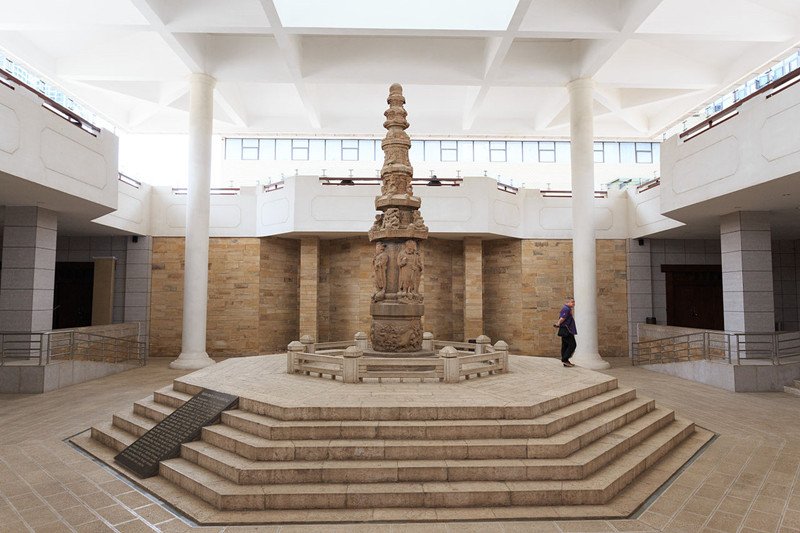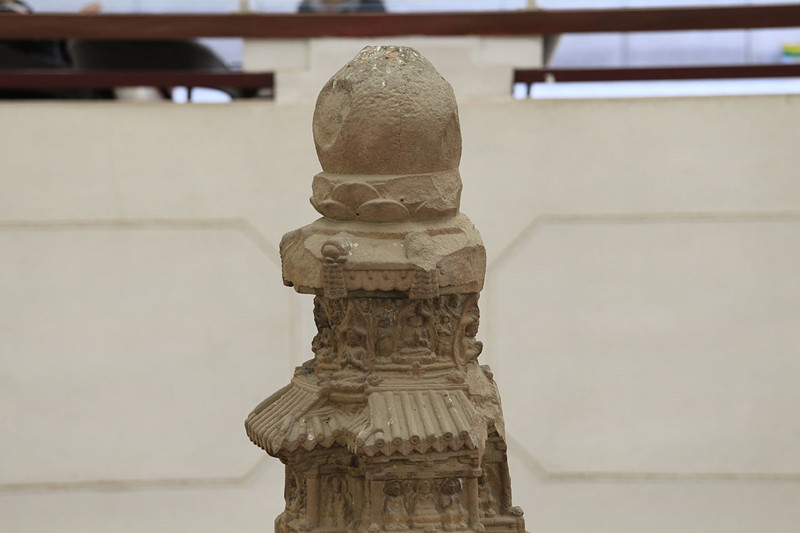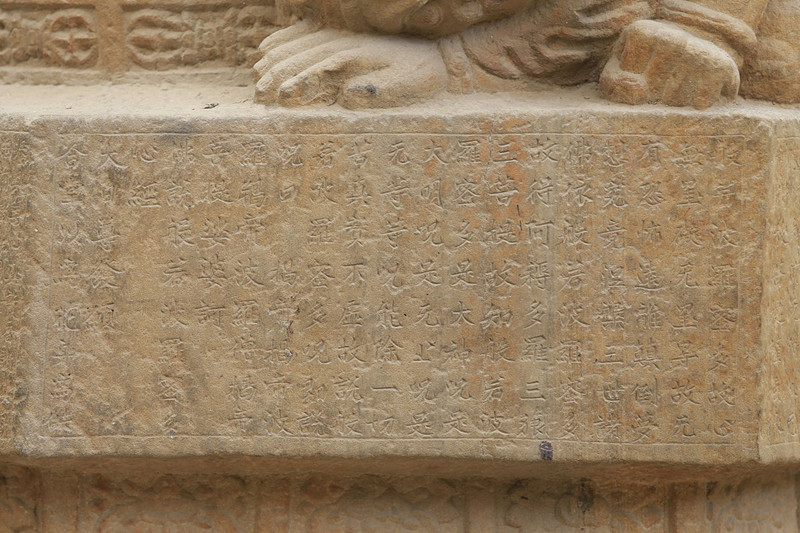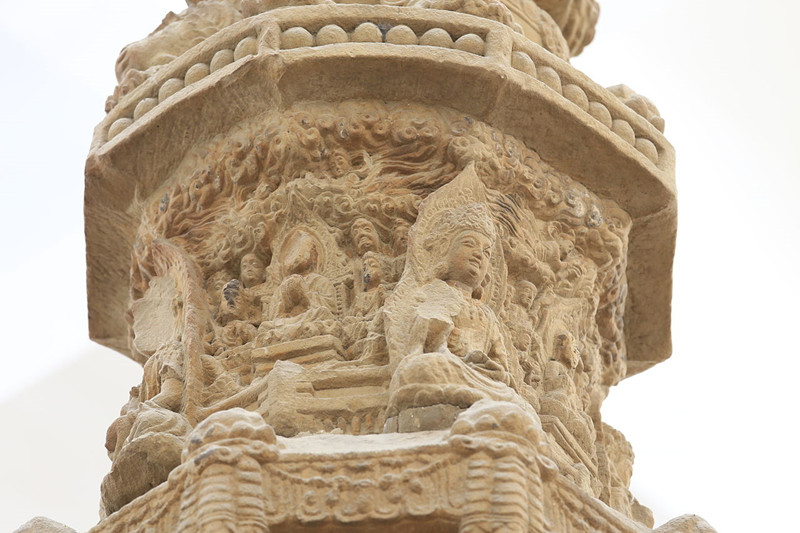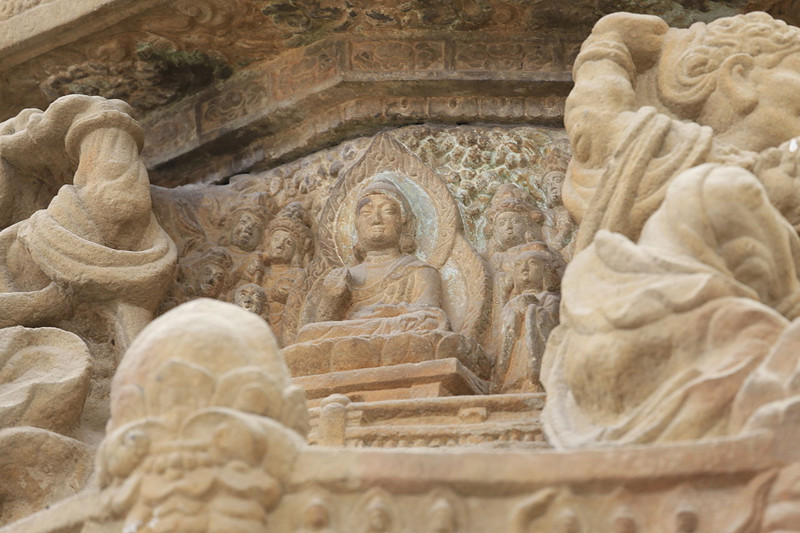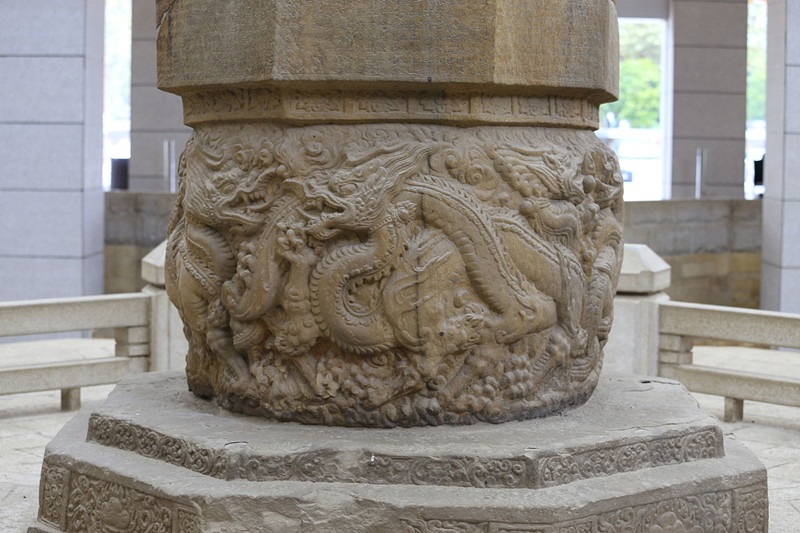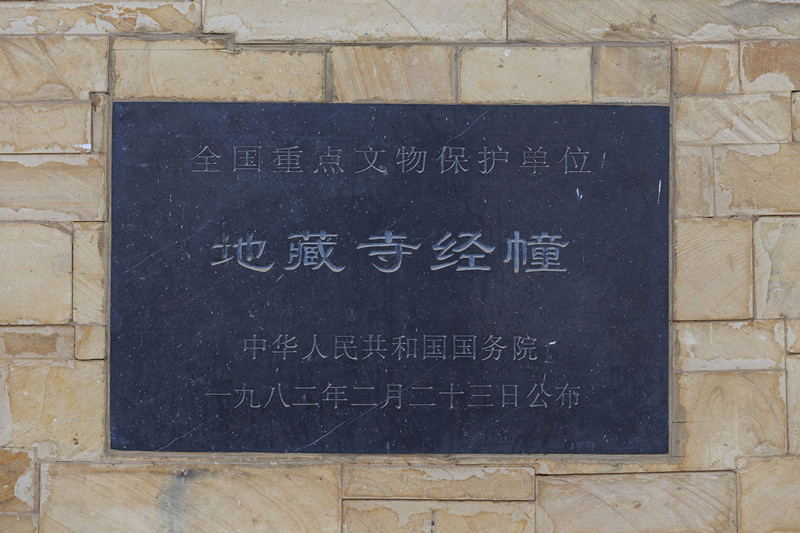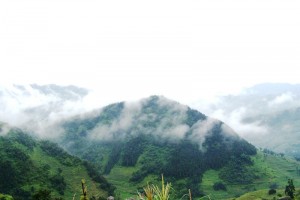Stone Sutra Pillar of Ksitigarbha Temple (Dizangsi) in Kunming
The Stone Sutra Pillar of Ksitigarbha Temple (地藏寺) is located at 93 Tuo Dong Road, Kunming City (昆明市), Yunnan Province (云南省), within the Kunming Museum (昆明市博物馆), which was formerly known as Guchuang Park (古幢公园). This historical structure, built during the Song Dynasty (宋代) in the Dali Kingdom (大理国) period, is also known as the “Dali Kingdom Sutra Pillar” (大理国经幢) and is commonly referred to as the “Ancient Pillar” (古幢). It belongs to a type of decorative tower known as a Huata (花塔).
Description and Features
The Sutra Pillar is sculpted from sandstone, presenting a slight yellow hue. It has seven tiers and reaches a total height of 6.5 meters. The structure comprises four parts: the top (幢顶), the body (幢身), the base (幢座), and the platform (台基), with an octagonal cross-section. The entire pillar is adorned with 288 exquisitely carved Buddhist figures of various sizes, with inscriptions of Buddhist scriptures in both Sanskrit and Chinese on the blank walls between the statues.
The artistic value of the Stone Sutra Pillar is significant in the fields of research, preservation, culture, and appreciation. It serves as a precious historical artifact for studying the history of ethnic religions, cultural history, Buddhist art, and the socio-economic context of the Dali Kingdom during the Southern Song Dynasty (南宋) period.
On February 23, 1982, the Stone Sutra Pillar was designated as a National Key Cultural Relic Protection Unit by the State Council of the People’s Republic of China (中华人民共和国国务院).
Name: Stone Sutra Pillar of Ksitigarbha Temple (地藏寺经幢)
Location: Kunming Museum (昆明市博物馆), Kunming City (昆明市), Yunnan Province (云南省)
Era: Late Southern Song Dynasty (绍兴年间晚期)
Protection Level: Second batch of National Key Cultural Relic Protection Units (第二批全国重点文物保护单位)
Approved by: State Council of the People’s Republic of China (中华人民共和国国务院)
Cultural Relic Number: 2-0044-4-002
Historical Development
The Stone Sutra Pillar was constructed during the reign of Duan Zhengxing (段正兴) in the Dali Kingdom, approximately in the late Southern Song Dynasty (绍兴年间晚期). The creator of the pillar was Yuan Douguang (袁豆光), a high-ranking official in the Dali Kingdom serving as the chief minister (议事布燮).
In the early years of the Republic of China (民国), due to wars, parts of the Sutra Pillar were buried underground. In 1919, the cultural relic department excavated the entire structure from the ruins of Ksitigarbha Temple. By 1923, the Kunming Municipal Government had restored the temple and converted it into Guchuang Park, enclosing it with iron railings for public viewing.
In 1955, Premier Zhou Enlai (周恩来) praised the Sutra Pillar during an inspection in Kunming and instructed the construction of a pavilion for its protection. In 1987, local authorities carried out comprehensive maintenance and protection of the Sutra Pillar, raising it by 1.8 meters with the addition of a new base.
From 1997 to 2000, during the construction of the Kunming Museum, the Sutra Pillar was integrated into the museum’s overall planning and construction. A glass building was added for overall protection, and the relic was managed as part of the museum’s collection.
Architectural Features
The Stone Sutra Pillar is carved from sandstone, featuring seven tiers that ascend from smaller to larger dimensions. The structure showcases intricate round sculptures, high reliefs, and flat carvings of figures, floral and cloud motifs, animals, mock wooden structures resembling pavilions and palaces, and inscriptions. The overall form resembles an eight-faced conical tower and is well-preserved.
The body of the pillar consists of several segments, each sculpted separately and then stacked. The first segment is long and thick, while the upper four segments are shorter and thinner. The joints between each segment are designed with circular tenons, showcasing sophisticated craftsmanship. The Sutra Pillar’s body is the main component, with the interface between upper and lower layers resembling an octagonal umbrella cover.
The artistic design of the Stone Sutra Pillar, positioned between towers, creates a striking visual effect. While the overall structure appears pagoda-like, the spacing between each layer is unequal, arranged according to aesthetic needs with a combination of square, octagonal, and circular shapes. This orderly combination reflects the ancient artisans’ profound aesthetic thought and artistic skill.
Most of the figures on the Sutra Pillar are high-relief sculptures, exhibiting a strong three-dimensional quality. The proportions of the figures are precise, giving them a lifelike presence. The Buddhist figures have solemn expressions, while the Bodhisattvas appear kind and gentle, reflecting the artistic styles of the Tang (唐) and Song (宋) dynasties. The carvings of palaces and pavilions mimic wooden structures, and their intricate details complement the overall clarity of the piece. Particularly, the arrangement of the Buddha and attendant figures is precise, with distinct hierarchical relationships. The smooth and soft lines of the sculptures, along with their meticulous craftsmanship, make the Stone Sutra Pillar a treasure of ancient sculptural art in Yunnan.
Cultural Relics
The base of the Stone Sutra Pillar is constructed from eight-sided stone steps (added in 1987), comprising five layers, with a bottom width of 11.7 meters, a top width of 8.75 meters, and a height of 1.1 meters. Atop this base lies an octagonal Sumeru seat (须弥座), centrally located and divided into three layers. The top and bottom ends are decorated with eight-sided ridges, with each face featuring cloud motifs and a waist resembling a drum shape, sculpted with swirling clouds and eight dragons, symbolizing the protective heavenly beings known as the Eight Divinities (天龙八部).
The upper surface of the Sumeru seat bears inscriptions in Chinese, including the “Heart Sutra” (般若婆罗密多心经), “Vow of the Great Sun Tathāgata” (大日尊发愿), “Four Great Vows” (发四宏誓愿), and “Record of the Creation of the Sutra Pillar” (敬造佛项尊胜宝幢记).
Levels of the Pillar
- First Level: Sculptures of the Four Heavenly Kings (四天王) representing the four cardinal directions: North, South, East, and West, each holding protective weapons. Each figure stands over 1 meter tall, clad in armor and displaying a solemn demeanor.
- Second Level: Features Buddha statues and images of Shakyamuni, with clear facial expressions and realistic clothing folds.
- Third Level: Around the central Buddha seat, four groups of Buddhas and Bodhisattvas are carved, including Avalokiteshvara (观世音菩萨) in the north and Ksitigarbha (地藏王菩萨) in the south.
- Fourth to Seventh Levels: The conical pillar narrows from large to small, depicting various Buddhas and attendants, along with motifs of palaces, pavilions, and lotus seats.
The apex of the pillar features a gourd-shaped finial (宝顶), intricately carved with Mani pearls, surrounded by lotus petals.
Historical and Cultural Significance
Ksitigarbha Temple (地藏寺)
Ksitigarbha Temple was established during the Dali Kingdom period. The Sutra Pillar was built by the monks Yongzhao (永照) and Yunzheng (云召) from Sichuan. In the fourth year of the Xuande reign (明宣德四年, 1429), it was renovated by monk Daozhen (道真). However, during the Xianfeng era (清咸丰七年, 1857), the temple was damaged in a war, leaving only the Sutra Pillar exposed among the remnants.
Historical Figures
Yuan Douguang (袁豆光) was a high-ranking official in the Dali Kingdom, serving as the chief minister and a senior official assisting in governance. He oversaw the construction of the Stone Sutra Pillar during the reign of Duan Zhengxing.
The “Record of the Creation of the Sutra Pillar” (造幢记) was written by Duan Jinquan (段进全), a disciple of Buddhism who also studied Confucianism, known in history as a “Ru Shi” (儒释).
Legends and Anecdotes
Long ago, five evil dragons resided in Dianchi Lake (滇池) in Kunming, destroying crops and homes. Zhang Sanfeng (张三丰) subdued the dragons with a magical bottle and instructed the villagers to build a demon-suppressing tower to imprison the dragons beneath a massive stone. This tale gives rise to the story of the ancient Sutra Pillar.
Cultural Relic Value
As a masterpiece of ancient Chinese stone carving art, the Stone Sutra Pillar holds substantial research, preservation, cultural, and aesthetic value. It is a critical artifact for studying ethnic religions, cultural history, Buddhist art, and the socio-economic context of the Dali Kingdom during the Southern Song Dynasty.
The Stone Sutra Pillar is a valuable treasure of historical and cultural significance in Yunnan Province, showcasing the skill and artistry of ancient craftsmen while contributing to the rich Buddhist heritage of the region.
